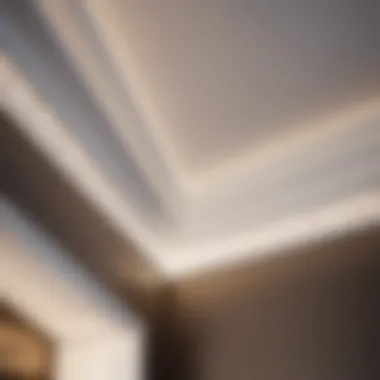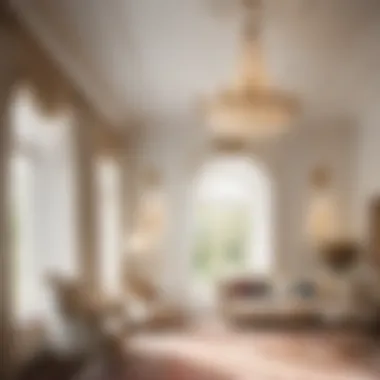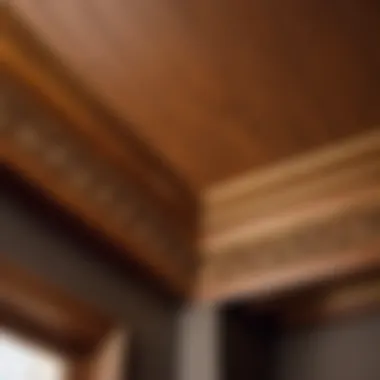Materials:
- Crown molding strips: 78 linear feet of 3.5-inch-wide primed polyurethane molding
- Miter saw: 12-inch compound miter saw for precise angled cuts
- Caulk: Paintable caulk to fill gaps and seams
- Stud finder: To locate studs for secure attachment
- Tape measure: Accurate measurements for a perfect fit
- Nail gun: Pneumatic nail gun for efficient and secure fastening
- Paint: High-quality paint for a flawless finish
DIY Steps:
-
Measure and Plan: Begin by measuring the perimeter of the room to determine the required molding length. Sketch a layout to visualize corners and joints.
-
Cutting Molding: Use the miter saw to cut molding at precise angles. Remember to cut inside corners with opposing angles for a seamless fit.
-
Installation Preparation: Locate the studs on the wall using a stud finder. Mark their locations to ensure secure attachment of the molding.
-
Attach Molding: Apply a bead of caulk along the back of the molding before securing it in place with a nail gun. Start with straight sections before tackling corners.
Technical Aspects:
- Timing: Allow sufficient time for measuring and cutting with precision. Plan for uninterrupted installation to maintain consistency.
- Tools: Ensure the miter saw is calibrated for accurate cuts. Use a level to ensure straight alignment during installation.
- Critical Techniques: Angle the miter saw for tight corner fits and adjust for variations in wall angles.
DIY Project Process:


-
Sequential Installation: Begin installing molding at one corner and work your way around the room, joining pieces at the corners with mitered cuts.
-
Troubleshooting Tips: If gaps appear, adjust the angles of the cuts or use caulk to fill them seamlessly. Sand any rough edges for a polished look.
Ensure to follow these steps meticulously to achieve a professional-looking result that enhances the architectural beauty of your living space.
Introduction


In the realm of interior design, crown molding stands as a cornerstone of architectural finesse and refinement. This article embarks on a journey to unravel the profound impact that crown molding has on elevating the aesthetics of living spaces. From its inception to its contemporary applications, the allure of crown molding is unmatched. We will explore the various styles, materials, and installation techniques that make crown molding a timeless and indispensable element in interior decor.
Understanding Crown Molding
Crown molding, often referred to as cornice molding, is a decorative trim installed along the seam where the walls meet the ceiling. Its primary function is to add a touch of sophistication and elegance to a room while also concealing any imperfections at the joinery. Understanding the nuances of crown molding involves appreciating its ability to visually raise ceiling height, create a cohesive transition between walls and ceilings, and enhance the overall architectural charm of a space.
Historical Evolution
The historical evolution of crown molding traces back centuries to ancient civilizations where it served as a symbol of wealth and status. Initially crafted from carved stone or wood, crown molding was a feature reserved for palaces and grand estates. Throughout history, crown molding styles have evolved to reflect changing design preferences and architectural trends, but its essence of opulence and grandeur remains steadfast.
Benefits in Interior Design
The incorporation of crown molding in interior design offers a myriad of benefits beyond its aesthetic appeal. One of the key advantages is its ability to create a visual anchor in a room, drawing the eye upward and highlighting the architectural details of a space. Additionally, crown molding can help conceal irregularities in ceiling height or wall imperfections, providing a seamless and polished finish to any room. Moreover, the versatility of crown molding allows it to complement a wide range of decor styles, from traditional to modern, making it a versatile and timeless design element.
Styles of Crown Molding


In the realm of interior design, crown molding stands as a quintessential element that adds a touch of timeless elegance to any space. When delving into the various styles of crown molding, one unveils a world of traditional profiles that embody classic charm and contemporary interpretations that exude modern finesse. Understanding the significance of styles of crown molding is paramount in achieving a cohesive and aesthetically pleasing decor. Whether opting for traditional profiles or contemporary designs, each selection contributes to the overall ambiance and architectural detail of a room.
Traditional Profiles
Egg-and-Dart
Exploring the classical allure of Egg-and-Dart crown molding reveals a timeless design featuring an intricate motif of alternating ovals (eggs) and arrows (darts). The distinct feature of Egg-and-Dart lies in its ability to introduce a sense of refinement and sophistication to a space. This traditional profile is a popular choice for those aiming to bring a sense of historic grandeur to their interiors. The unique detail of Egg-and-Dart showcases a perfect balance between opulence and subtlety, creating a visually appealing architectural accent within a room that captivates the eye and enhances the overall aesthetic.
Dentil
Dentil molding showcases a series of small, rectangular blocks resembling teeth, evoking a sense of classical architectural detailing. Its prominent feature lies in the repetition of these tooth-like blocks along the length of the molding, adding a structured and symmetrical element to the decor. Dentil molding is favored for its ability to bring a sense of order and formality to a space. Although its repetitive pattern adds a sense of visual interest, the intricacy and formality of Dentil molding may not suit every design aesthetic, requiring a discerning eye for compatibility and balance within the overall interior design.
Cove
Characterized by its concave shape that blends seamlessly between walls and ceilings, Cove molding exudes a soft and graceful appearance within a room. The key characteristic of Cove molding lies in its ability to create a smooth transition between walls and ceilings, enhancing the architectural flow and providing a subtle, elegant touch to the space. Cove molding is a popular choice for those seeking to add a touch of understated sophistication to their interiors. While Cove molding offers a seamless and soft design element, its installation and maintenance may require careful attention to detail to ensure a flawless integration with the overall decor.
Contemporary Interpretations
In contrast to traditional profiles, contemporary interpretations of crown molding embrace sleek lines, geometric patterns, and minimalist designs that cater to a more modern aesthetic. These interpretations offer a fresh perspective on crown molding, allowing for a seamless integration of architectural charm with a contemporary flair. By exploring clean lines, geometric patterns, and minimalistic designs, individuals can infuse their interiors with a harmonious blend of tradition and innovation, creating a striking visual impact that resonates with current design trends.
Clean Lines
Clean Lines crown molding epitomizes simplicity and sleekness, featuring well-defined and unembellished profiles that accentuate the architectural elements of a room. The key characteristic of Clean Lines molding lies in its ability to create a clean and seamless transition between walls and ceilings, adding a touch of modern sophistication to the space. This style is a beneficial choice for those looking to achieve a minimalist aesthetic while still incorporating the structural elegance of crown molding into their decor.
Geometric Patterns
Geometric Patterns crown molding introduces a contemporary twist to traditional crown molding by incorporating geometric shapes and patterns that elevate the visual interest of a room. The key characteristic of Geometric Patterns lies in its ability to create a dynamic and eye-catching appeal within the space, offering a modern and artistic interpretation of crown molding. This style is a popular choice for homeowners seeking to infuse their interiors with a unique design element that showcases creativity and originality.
Minimalistic Designs
Minimalistic Designs crown molding showcases a restrained and understated aesthetic, focusing on clean lines and subtle detailing that contribute to a sense of simplicity and sophistication. The key characteristic of Minimalistic Designs lies in its ability to blend seamlessly with various design styles, offering a versatile and modern approach to crown molding. This style is a beneficial choice for those looking to achieve a contemporary and uncluttered look within their interiors while still incorporating the timeless appeal of crown molding.
Materials Used
Crown molding in interior design is not just about aesthetics; it also involves careful consideration of the materials used. The choice of materials can greatly impact the overall look, feel, and durability of the molding. Understanding the different materials available for crown molding is crucial in making informed decisions for your home. Let's explore the various options:
Wooden Molding
Wooden molding is a classic choice that exudes elegance and warmth. It is a popular option due to its versatility, allowing for intricate designs and detailing. One of the key benefits of wooden molding is its ability to be stained or painted to match any decor style or color scheme. However, it is important to note that wooden molding may require more maintenance compared to other materials, as it is prone to warping or rotting in high humidity environments. When opting for wooden molding, consider the type of wood used, such as oak, pine, or maple, as each type offers unique characteristics in terms of grain patterns and durability.
Polyurethane Molding
Polyurethane molding is a modern alternative to traditional wooden molding. It is lightweight, durable, and easy to install, making it a popular choice for DIY enthusiasts. One of the main advantages of polyurethane molding is its resistance to moisture, making it ideal for areas prone to humidity or moisture buildup such as bathrooms or kitchens. Additionally, polyurethane molding is low maintenance and can be easily cleaned with a damp cloth, making it a practical option for busy homeowners. When considering polyurethane molding, look for options that closely resemble the look and feel of real wood without the risk of damage from environmental factors.
Plaster Molding
Plaster molding is a luxurious choice that adds a touch of grandeur to any space. It is highly customizable, allowing for intricate designs and custom shapes that can't be achieved with other materials. Plaster molding is durable and long-lasting, making it a worthwhile investment for those looking to elevate their interior decor. However, plaster molding is best installed by professionals due to its weight and fragility during handling. When opting for plaster molding, ensure to work with experienced installers who can create seamless transitions and flawless finishes for a truly refined look in your home.
Installation Techniques
In the realm of interior design, crown molding stands out as a prominent feature that adds a touch of elegance and sophistication to any space. Installation techniques play a crucial role in ensuring that crown molding is securely and seamlessly fitted to enhance the architectural beauty of a room. Proper installation techniques not only contribute to the aesthetic appeal but also ensure the longevity and durability of the crown molding.
Understanding the intricacies of installation techniques is vital to achieving a flawless finish. From measuring and cutting the molding accurately to joining corners with precision and attaching the molding securely to walls and ceilings, each step demands attention to detail and expert craftsmanship.
When it comes to installing crown molding, precision is key. Measuring and cutting the molding to the exact dimensions is essential to achieving a seamless fit and a polished look. Cutting the angles correctly is crucial to ensure that the pieces align perfectly at corners, creating a harmonious flow throughout the room.
Joining corners seamlessly is a skill that requires finesse and precision. Properly mitering the corners and ensuring a snug fit is essential for a professional finish. By using the right tools and techniques, corners can be joined seamlessly, giving the illusion of a single, continuous piece of molding.
Attaching crown molding to walls and ceilings requires careful planning and execution. Using the appropriate adhesive or nails and ensuring secure fastening is necessary to prevent any potential issues in the future. Proper attachment techniques not only enhance the aesthetic appeal of the molding but also contribute to its structural stability.
Maintenance and Care
In the realm of interior design, maintenance and care play a crucial role in preserving the beauty and functionality of crown molding. This section focuses on the significance of proper upkeep to ensure the longevity of your investment in crown molding. Understanding the specific elements and benefits of maintenance and care is essential for homeowners looking to maintain a pristine and elegant living space.
Cleaning Tips
Cleaning crown molding is a fundamental aspect of its upkeep. Dust, dirt, and grime can accumulate over time, diminishing the aesthetic appeal of the molding. To maintain its luster, regular dusting with a soft microfiber cloth or a gentle brush is recommended. For a deeper clean, a solution of mild soap and water can be used, taking care to dry the molding thoroughly to prevent water damage. Additionally, avoiding harsh chemical cleaners is crucial to preserve the finish of the molding.
Repairing Damages
Despite meticulous care, crown molding may encounter damage over time due to various factors such as accidental impacts or moisture exposure. This section delves into essential tips for repairing damages to ensure the seamless restoration of the molding's integrity. From minor scratches to more significant dents or cracks, understanding the appropriate repair techniques is vital. Utilizing wood fillers for wooden moldings or specialized patching compounds for alternative materials can help address imperfections effectively. Proper sanding, priming, and painting techniques are also crucial to achieve a flawless repair finish, maintaining the overall aesthetics of the crown molding.
Innovative Uses of Crown Molding
In the realm of interior design, innovative uses of crown molding hold a distinctive position in elevating the aesthetics and functionality of a space. By pushing the boundaries of traditional applications, these creative solutions add a touch of uniqueness and sophistication to any room. Let's explore the significant role that innovative uses of crown molding play in creating dynamic and visually striking interiors.
Integrated Lighting Solutions
Integrated lighting solutions represent a cutting-edge approach to integrating crown molding into modern interior designs. By incorporating built-in lighting within the molding structures, homeowners can achieve a harmonious blend of ambient lighting and architectural detail. This innovative use not only illuminates the space but also highlights the intricate patterns and textures of the crown molding, creating a dramatic visual impact. Design considerations such as the type of lighting fixtures, placement for optimal illumination, and seamless integration with the overall design scheme are crucial for achieving a cohesive and impactful result.
Multi-Level Molding
Multi-level molding introduces a sense of dimension and hierarchy to interior spaces, transforming conventional flat walls and ceilings into dynamic architectural features. By incorporating multiple levels of crown molding at varying heights, homeowners can create visual interest and depth within a room. This technique allows for the delineation of different functional areas, highlighting specific architectural details, and adding a sense of grandeur to the overall design. Careful planning, precise measurements, and seamless transitions between molding levels are essential in achieving a balanced and visually appealing multi-level effect.
Contrast and Color Play
The strategic use of contrast and color play in crown molding design can enhance the overall visual impact of a room while serving as a statement piece in the interior decor. Contrasting the color of the molding with the walls or ceilings can create a bold and eye-catching focal point, drawing attention to architectural features and adding personality to the space. Additionally, experimenting with different finishes, such as matte, glossy, or metallic, can further amplify the visual interest and artistic flair of the crown molding. Considerations such as color harmony, proportion, and overall design cohesion must be carefully weighed to achieve a cohesive and impactful contrast and color play effect.





